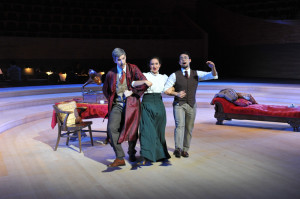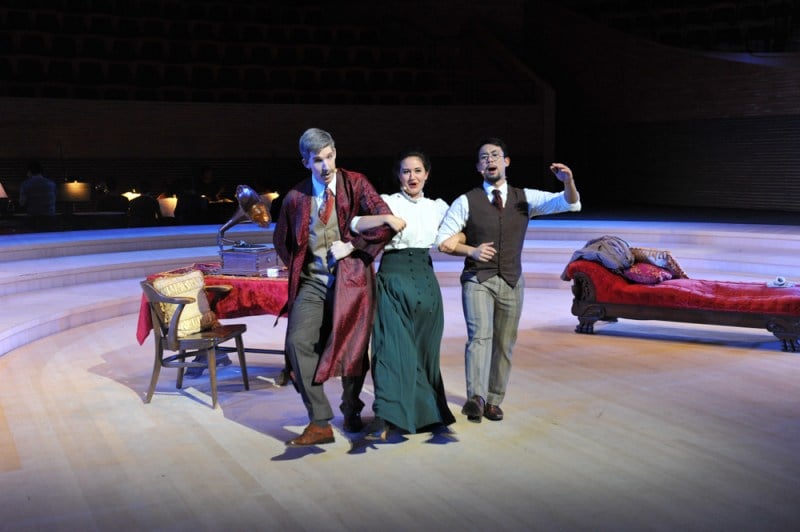Say the words “My Fair Lady,” and one is more likely to recall images of Audrey Hepburn than questions of race.
The Stanford Asian American Theater Project’s recent production of “My Fair Lady” boldly re-envisions the musical, however, by creating an Asian-inspired version of the show, infusing the musical with the politics of racial identity. As Ken Savage ’14’s senior project for the Theater and Performance Studies major, the show deftly transforms the story of “My Fair Lady” from a quaint tale of maneuvering vowel sounds to a compelling story of Asian identity formation in the Western world by exploring the cultural expectations surrounding speech, dress and behavior and questions of assimilation.

The show, which sold out twice as the first student production to be shown in Bing Concert Hall, follows an Asian Henry Higgins and an Asian Eliza Doolittle in early 20th century London. The character of Henry Higgins represents the upper-class English elite in the traditional version of “My Fair Lady,” yet in this Asian-inspired production, Henry Higgins (played by the capable Max Savage ’16 — Ken’s younger brother) is a more complex being. Savage embodies an Asian man with an elite, wealthy and Westernized Asian identity, signaled by his beautiful English dress and high society English dialect, and fully plays out his character as an unapologetically narrow-minded academic whose quirks we both despise and love.
Eliza Doolittle (played by Saya Jenks ’16), represents the opposite end of the identity spectrum in this show — she has a rough Cockney accent and dirtied clothes to represent a non-elite identity, which, in contrast to Higgins, held implications of a poor, non-assimilated, Asian identity. Jenks gave the audience an intensely animated version of Doolittle, all groans and squeals, and seemed to be operating in full gear from start to finish.
As the show unfolds, however, it stays true to the original script. This was a wise choice on Savage’s part, because the plot, with the addition of a racial lens, creates intriguing ideological tensions with every song and scene. When, in the first scene of the show, Higgins sang “An Englishman’s way of speaking absolutely classifies him,” we could already hear the lyrics echo with deep cultural implications based on the world Savage creates. Later, when Higgins bet he could turn Eliza Doolittle into a “lady,” we wondered what the definition of a lady is, in terms of cultural expectations for an Asian Eliza. The audience may have even been nudged towards reconsidering the significance and perhaps hidden meaning of the word “fair” in “My Fair Lady,” as it pertains to Asian cultural norms and Western assimilation.
Yet, perhaps most importantly, Savage and his creative team refuse to allow for a strict binary between Western identity and Eastern identity, high-class and low-class, rich and poor. Every character in this play seemed to exist on some sort of cultural identity spectrum, including the members of the ensemble. There was room for hybridity in racial identity. Some street vendors wear Westernized clothing but speak in a Cockney accent, while some maids in the Higgins household maintain an elite British dialect but dress in traditionally Eastern attire — the combinations are seemingly endless.
Also vital to this process is the excellent costume and set design, done by the talented Asia Chao ’15. Higgins’ home is decorated in swatches of red and yellow seemingly oriental patterns, and a recognizable icon of East-meets-West — vase of blue and white Chinese porcelain — is seen in almost every scene of the show. And speaking of blue and white, the costumes featured in “Ascot Gavotte” (my favorite scene in the show) are positively lavish English-style gowns, hats, suits, canes, parasols and the like. Yet, these Western modes of dress are done entirely in blue and white as an explicit nod to Chinese porcelain (as well as a brilliant play on the original black and white from the 1964 film). The ensemble shows their abilities vocally and physically during this scene, nailing the stylized crispness and haughty atmosphere of a day at the races in British high society.
Standout performances also include Jin Park ’16 as Alfred Doolittle, who delivered several show-stopping comedic music numbers with vocal and physical ease; Weston Gaylord ’15 as Colonel Pickering, whose comedic timing oils the wheels of every scene he enters; and Andrew Forsyth ’14 as Freddy Eynesford-Hill, whose voice is angelic enough during “On The Street Where You Live” it could have warranted had two or three more reprises.
This show is clearly the product of much time, funding, effort, thought and creative inspiration. It has nearly all the gloss and gleam of a professional production and meets a unique and valuable goal: to endow a well-known musical with the power to think critically about racial identity. A job well done.
Contact Katie Straub at kcstraub ‘at’ stanford.edu.
